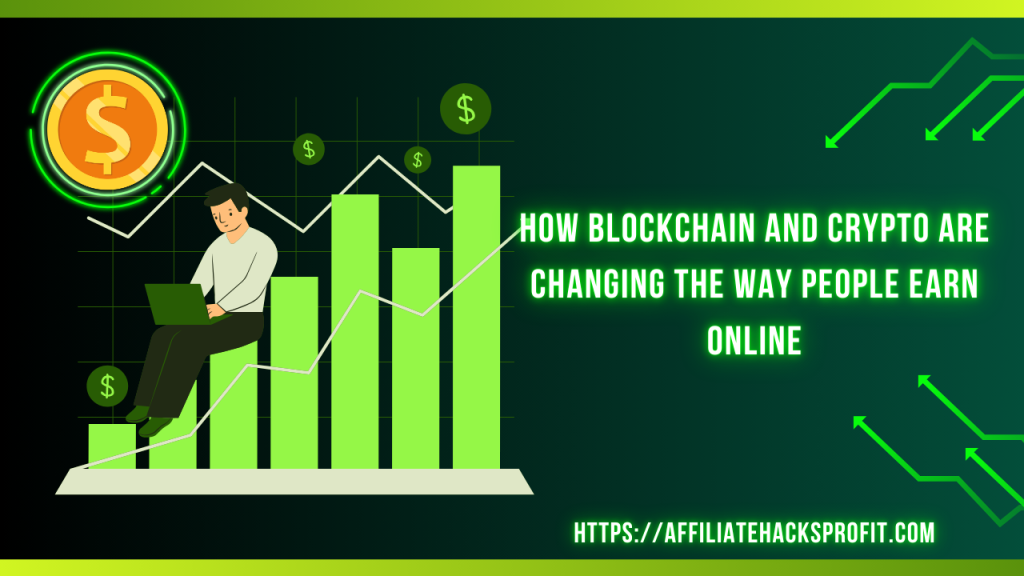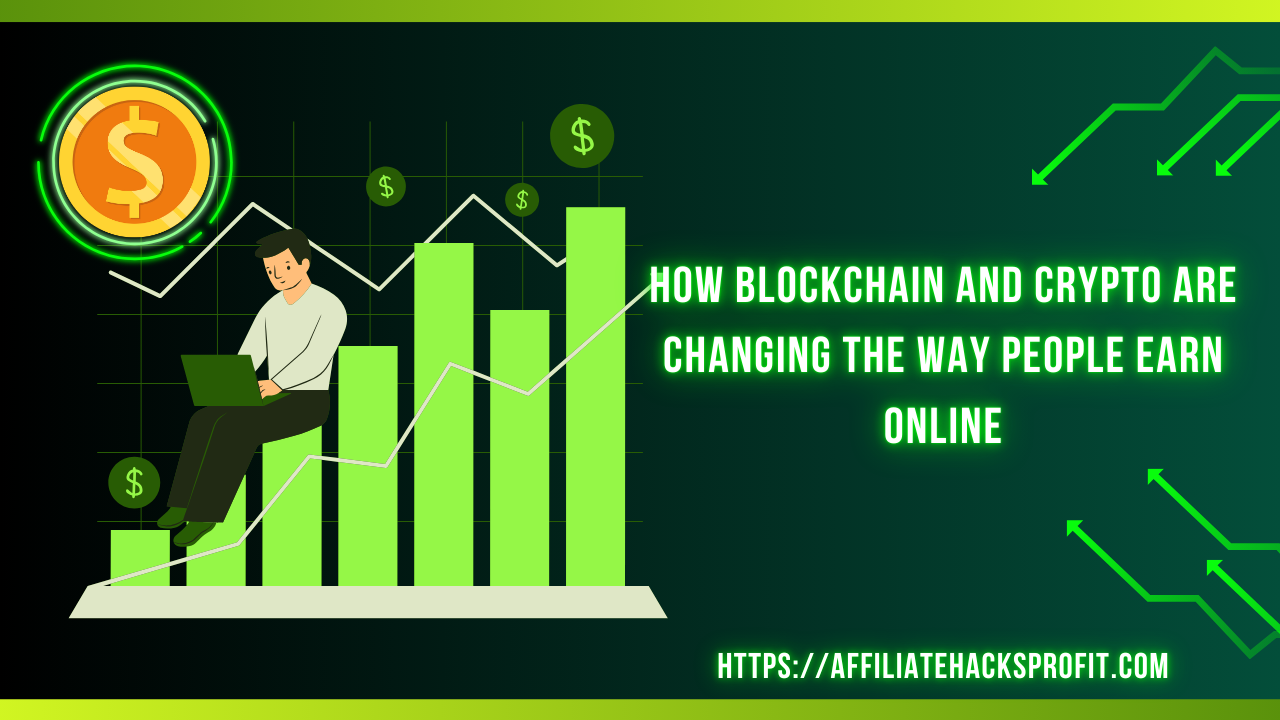Welcome to my article “How Blockchain and Crypto Are Changing the Way People Earn Online”. The internet has always been a goldmine for people looking to make money online, but let’s be honest—traditional methods like freelancing, dropshipping, and YouTube ad revenue often come with their own set of headaches. High transaction fees, middlemen taking a cut, and the occasional “oops, your payment is delayed” email have been frustrating for years. But enter blockchain and cryptocurrency, and suddenly, the rules of the game are changing. Whether it’s earning passive income through staking, making money by playing video games (yes, your mom was wrong about that one), or selling digital art as NFTs, crypto is shaking up the way people earn online like never before.
From decentralized finance (DeFi) offering bank-like services without the banks to Web3 platforms giving creators more control over their earnings, blockchain is making the online economy more open, fair, and—dare we say—exciting. Of course, it’s not all sunshine and instant Lambos; navigating the crypto world requires some learning, patience, and a tolerance for the occasional market rollercoaster. But for those willing to adapt, the earning potential is vast, and the future of online income looks more decentralized than ever. Let’s dive into how blockchain and crypto are redefining digital hustles!
Steve is Making $20K+ monthly – Discover the EXACT SAME Secrets to Make $5,000-$10,000 Monthly >>>

Decentralized Finance (DeFi) and Passive Income Opportunities
Remember when your bank used to give you actual interest on your savings instead of just a polite “thank you for your deposit”? Yeah, those days are long gone. But thanks to Decentralized Finance (DeFi), you can now earn passive income without relying on traditional banks—no middlemen, no unnecessary fees, just you, your crypto, and a few smart contracts doing all the heavy lifting.
One of the easiest ways to earn in DeFi is through staking, where you lock up your crypto to support a network and, in return, earn rewards. Think of it as putting your money in a high-yield savings account, but instead of a measly 0.01% APY, you might earn anywhere from 5% to 20% (or even more, depending on the platform). Then there’s yield farming, where you lend out your crypto to DeFi protocols and get rewarded with interest and governance tokens—kind of like letting your money work overtime while you sleep. For the more adventurous, liquidity mining allows users to provide funds to decentralized exchanges and earn a share of the trading fees.
Of course, with great rewards come great risks. DeFi platforms are still evolving, and the occasional rug pull (crypto slang for a sudden exit scam) can leave investors empty-handed. Smart contracts, while brilliant, aren’t foolproof, and a bad hack can drain an entire platform overnight. So, while DeFi can be a fantastic way to grow your wealth, always DYOR (Do Your Own Research) and never invest more than you’re willing to lose. That said, if you play it smart, your crypto might just work harder for you than any 9-to-5 ever did.
Play-to-Earn (P2E) Gaming and Metaverse Jobs
Once upon a time, spending hours gaming was considered a “waste of time.” Fast forward to today, and Play-to-Earn (P2E) gaming has flipped that idea on its head—because now, playing video games can actually make you money. Thanks to blockchain technology, gamers can earn crypto, collect valuable in-game assets, and even trade them for real-world cash. So, the next time someone tells you to “stop wasting time on that game,” you can proudly say, “I’m working.”
Games like Axie Infinity, The Sandbox, and Decentraland have pioneered this new era where in-game characters, virtual land, and rare items exist as NFTs (non-fungible tokens) that hold real-world value. Some players earn by battling in P2E games, others by flipping digital assets, and a few even by renting out their NFT characters to other players (yes, being a virtual landlord is a thing now). But it doesn’t stop there—metaverse jobs are becoming a reality, with people making money as virtual real estate agents, fashion designers for avatars, and even event planners for digital concerts. Who knew that throwing a party in the metaverse could be a legitimate career path?
Of course, like any gold rush, P2E gaming comes with its share of risks. Many games require an initial investment (sometimes costly), and not all projects stand the test of time—some crash harder than your WiFi when you need it most. The key is to research, find sustainable projects, and, most importantly, have fun while earning. After all, if you’re going to make money online, why not do it by playing games?
Freelancing and Gig Economy with Crypto Payments
Freelancing used to be simple: do the work, send an invoice, wait an eternity for payment, and then argue with PayPal about why they froze your account for “suspicious activity.” But thanks to crypto payments, freelancers are ditching slow bank transfers and hefty fees in favor of instant, borderless transactions. Whether you’re a writer, developer, designer, or even a virtual assistant, getting paid in Bitcoin, Ethereum, or stablecoins means no more middlemen taking a cut—just pure, unfiltered earnings.
Platforms like Bitwage, CryptoGrind, and Ethlance are leading the charge in crypto freelancing, allowing workers to receive payments directly in crypto without dealing with exchange rates or banking delays. Plus, smart contracts are making work agreements more secure—imagine an escrow system that automatically releases your payment once the job is completed, no more chasing down clients who “forgot” to pay. And for those worried about crypto’s infamous volatility? Enter stablecoins like USDT and USDC, which offer the benefits of crypto payments without the rollercoaster price swings.
Steve is Making $20K+ monthly – Discover the EXACT SAME Secrets to Make $5,000-$10,000 Monthly >>>
Of course, crypto freelancing isn’t perfect. Taxes can get complicated, regulations are still evolving, and if you send your payment to the wrong wallet address—well, let’s just say customer support won’t be there to help. But for freelancers tired of platform fees, slow transactions, and cross-border payment nightmares, crypto is proving to be a game-changer. Just remember: get paid, convert what you need, and HODL the rest—your future self might just thank you.
Content Creation, NFTs, and Web3 Monetization
If you’ve ever poured your heart into a blog, video, or piece of art only to see a platform take most of the revenue (looking at you, YouTube and Instagram), then Web3 might just be your new best friend. The days of fighting the algorithm for pennies are fading, and blockchain-based monetization is giving creators direct control over their earnings—no middlemen, no gatekeepers, just pure creator power.
Enter NFTs (Non-Fungible Tokens), which allow artists, musicians, and writers to sell their digital work as unique, blockchain-verified assets. Instead of relying on ads or sponsorships, creators can sell their music, e-books, or even memes as NFTs—yes, even memes can be worth thousands. Platforms like OpenSea, Foundation, and Zora have turned digital collectibles into a multi-billion-dollar industry. Plus, NFT creators can earn royalties forever, meaning every time their work is resold, they get a cut. Imagine selling a digital painting and still making money off it years later—sounds better than waiting for YouTube’s next monetization policy change, right?
And it doesn’t stop at NFTs. Web3 platforms like Mirror (for writers), Audius (for musicians), and Lens Protocol (for social media) are reinventing how creators engage with their audience. Instead of relying on ad revenue or brand deals, fans can directly support their favorite creators with crypto, making monetization more transparent and sustainable. Of course, Web3 is still the Wild West—scams exist, gas fees can be ridiculous, and not every project will survive. But for content creators tired of platform restrictions, demonetization scares, and ever-changing rules, Web3 offers something revolutionary: creative freedom with financial independence.
Earning Through Crypto Trading, Airdrops, and Mining
If you’ve ever stared at a crypto chart and thought, “This looks like a heart monitor on caffeine,” welcome to the world of crypto trading—where fortunes are made, lost, and sometimes meme’d into existence overnight. Unlike traditional stocks, crypto markets run 24/7, meaning you can trade Bitcoin at 3 AM in your pajamas if that’s your thing. Whether it’s spot trading (buy low, sell high), futures trading (betting on price movements with leverage), or arbitrage (exploiting price differences across exchanges), there are plenty of ways to turn market volatility into profit—if you can handle the adrenaline rush.
Steve is Making $20K+ monthly – Discover the EXACT SAME Secrets to Make $5,000-$10,000 Monthly >>>
For those who prefer free money (who doesn’t?), there’s airdrop farming—a method where blockchain projects literally give away tokens to early adopters in hopes of building hype. All you usually need to do is sign up, complete a few tasks (like tweeting or joining a Discord), and voilà—free crypto in your wallet. Some airdrops turn out to be worthless, while others, like Uniswap’s 2020 airdrop, gave users thousands of dollars just for using the platform. Not bad for a couple of clicks, right?
Then there’s crypto mining, the OG way to earn digital gold. While Bitcoin mining now requires industrial-level equipment and cheap electricity, altcoin mining and cloud mining still offer opportunities for solo miners. And if mining hardware isn’t your thing, staking provides a mining alternative—just lock up your coins and earn passive rewards, no noisy machines required.
Of course, all of this comes with risks. Trading is not for the faint of heart (or those who check their portfolio five times a minute), airdrops can sometimes be scams, and mining can burn through electricity faster than your gaming PC on max settings. But for those who learn the ropes and manage risk wisely, crypto offers endless earning possibilities—just remember: never invest more than you’re willing to lose, and don’t fall for the hype tweets promising instant riches.

Conclusion
If there’s one thing clear about blockchain and crypto, it’s that they’re flipping the script on how people make money online. Whether you’re staking your way to passive income, gaming for crypto, freelancing without middlemen, minting NFTs, or riding the rollercoaster of crypto trading, the opportunities are endless. No more waiting weeks for a bank transfer, no more platform fees eating into your hard-earned cash—just decentralized, borderless, and (mostly) permissionless earning potential at your fingertips.
Steve is Making $20K+ monthly – Discover the EXACT SAME Secrets to Make $5,000-$10,000 Monthly >>>
Of course, it’s not all easy money and moon missions. The crypto world is still evolving, and with innovation comes risk—rug pulls, market crashes, and scams are all part of the game. But for those willing to do their research, adapt, and stay ahead of the curve, the future of online income looks more decentralized, fair, and full of opportunities than ever before. So, whether you’re here for the side hustle, the full-time crypto grind, or just curious about what’s next, one thing’s for sure—the way people earn online will never be the same again.
Thank you for reading my article “How Blockchain and Crypto Are Changing the Way People Earn Online” till the end. See you in another.











